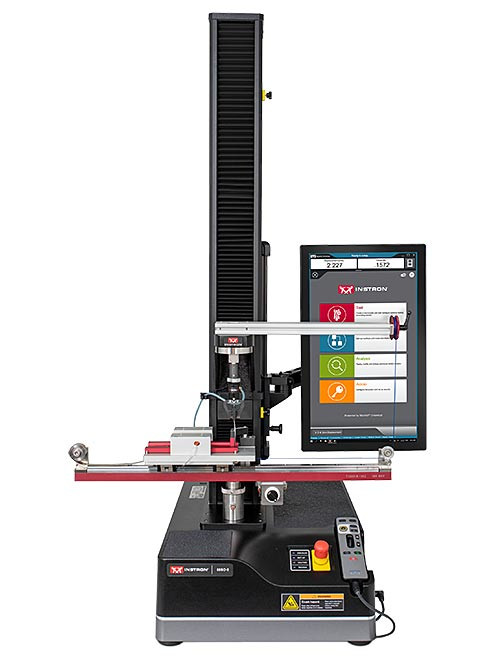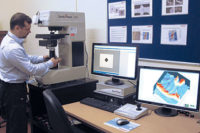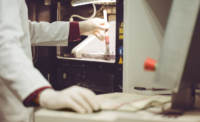Universal testers test the strength of a product, component, or material. This measurement often indicates if an item is functional and safe. Such systems are essential to quality in many industries because they help engineers understand the performance of materials, components, and products under various loading conditions. In other words, this testing provides critical data that enables engineers to make informed decisions during the product development process.
"Universal tension and compression testing machines quantify the behavior and performance of materials, components, and assemblies," says Mark Fridman, president, MARK-10. "By subjecting these samples to push and pull forces with fixtures of specific geometries, tests can be tailored to the particular quality objective. Whether destroying the sample or merely exercising it, the resulting force and distance data can quantify its quality, providing a pass/fail result or force-distance curve that can be compared against expected behavior."

What You Need to Know About Universal Testing
Moses Da Rocha, product and applications manager, PPT Group, explains the trends in universal testing.
Listen to more Quality podcasts.
Once a product reaches production level manufacturing, universal testing systems continue to play an important role in the form of quality testing, says Ian Kirk, product manager, Instron.
"This stage of the process is crucial for ensuring the product meets the necessary requirements and reduces the risk of bad product leaving the factory," Kirk explains. "The severity of this risk depends on the type of product being shipped."
For example, if a batch of bottle caps ships with a defect that causes part of it to break off, the risk of failure is somewhat low and may only result in some negative consumer sentiment in the form of bad online reviews, Kirk says. However, components used in the aerospace, automotive, and biomedical industries have a much higher risk of failure.
"When product defects are detected in these industries it can result in devastating consequences such as massive recalls, lawsuits, loss of contracts, and risk to continuity of business," Kirk says. "In either case, defective product is a liability for both the consumer and the manufacturer, making quality a primary concern for all industries. Universal testing systems are a fundamental part of this process."
Automation’s Growing Role
Experts notice a trend towards what Moses Da Rocha, product and applications manager, PPT Group, calls "optical measurement of strain rather than physical contact on the specimen." This change reduces the risk of affecting measurement accuracy.
Automation has also impacted the field. Fridman says it is a key driving force for recent advancements in force measurement. By embracing automation, he says manufacturers can create repeatable test methods that are difficult to perform incorrectly; save labor costs by reducing the involvement of the operator in the testing process; and gather more and better data to understand trends, more quickly identify current problems, and predict future issues with greater accuracy.
Organizations are beginning to hire staff to help implement automation, including in testing labs.

Universal Testing Machine with Pneumatic Peel Fixture | Image Source: Instron
"Many testing labs have seen increased demands, requiring them to find ways to do more testing with existing resources. A major benefit of automation is that it can free up an operator or engineer from having to stand at the frame while tests are underway," Kirk says. "Instead, they can move around the lab and focus on more value-added tasks."
There are also more ways than ever to automate testing, whether it be XY stages, carousels, or cobots for small to medium sized batch testing, or full robotic systems that are capable of handling 24/7 unattended testing, he says.
"From an application standpoint, universal testing machine manufacturers are constantly having to adapt to macro trends in the market," says Kirk. For instance, the automotive market is shifting towards electrification.
"Governments around the world are passing laws to phase out the sale of new internal combustion engine vehicles, consumer preferences are changing, and auto manufacturers are racing to adapt," he says. "Electric vehicle battery technology is quickly evolving and requires a tremendous amount of testing. As materials and battery structures change, so must the testing equipment. This comes in the form of custom fixturing, safe environmental chambers for testing live batteries, and testing setups that can keep up with the incredible throughput demands."
The universal testing field has not been immune to pandemic-induced changes. For example, this technology was highly in demand when manufacturers that moved their production towards personal preparedness equipment and needed to test for compliance and larger volumes.
"A business that had previously tested only one type of product now needed to use their universal testing systems to test masks, gloves, swabs, or gowns," Kirk says. "The beauty of universal testing systems is that they are incredibly adaptable to changing requirements. Many labs just needed to change a fixture, switch their test method, and they were ready to go."
"By changing the grips and fixtures, the universal tester can perform quality checks on different end products by applying force in the required manner," Da Rocha says. "Software allows specific standard procedures to be run for that unique specimen. The ability to automate and run in batches enables manufacturers to increase throughput to match demand. Masks, syringes and ventilator components all had production increases, and medical products have particularly strict protocols in their quality assurance testing."
Pandemic-Era Support
As businesses around the globe shut down early in the pandemic, manufacturing sites largely stayed open.
"Universal testers were used in manufacturing facilities around the world during the pandemic to measure the quality of these items before they leave the dock," Fridman says. "Because of network integration and robust data presentation, quality professionals could make important decisions even if they were working remotely. As the pandemic accelerated innovation in remote software tools, universal tester manufacturers have responded by adding features and functions suited to a dispersed workforce."
The pandemic has also brought previously unidentified or underestimated business risks to the surface, such as what Fridman calls "the uncertainty of labor." This may have also boosted automation implementation.
When lockdowns, social distancing requirements, and mass early retirements happened, many organizations turned to automation, which can help a lab maintain testing volumes even with constrained labor resources, Kirk says.
Evolving Relevance
As technology evolves, the main benefit of modern computer-driven equipment is that data collection and analysis is becoming more integrated with other quality management system processes, Da Rocha says.
"The flexibility afforded by software allows these universal testers to perform more specialized testing," he explains. "Information regarding how a final product has performed in a quality assurance test can also be easily fed back into design or manufacturing operations, shared with other geographically distributed areas of the business and sent onward to customers—all seamlessly in the digital domain."
The challenge, he says, is evolving to meet the requirements of handling more data. "IT security considerations are now influential in implementing modern physical testing equipment," he says. Some industries stipulate strict rules as to how this must be done in order to be certified within that business sector.



